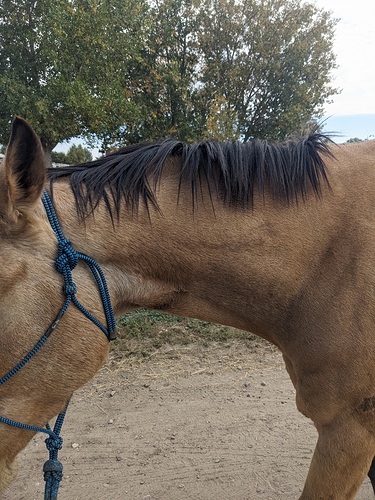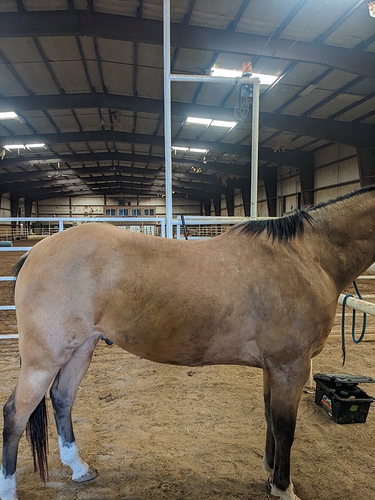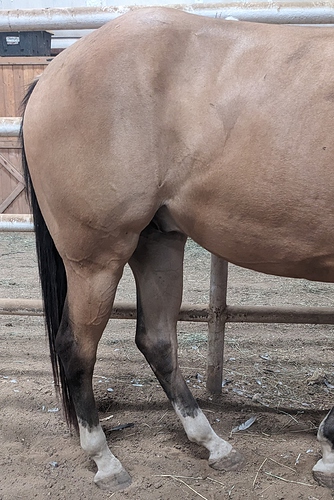Hindsight can be a blessing and a curse  Don’t beat yourself up. As much as you love him and want him to be fixed, family still comes first. AND, think of how many situations with similar symptoms have improved with 6-12 months turned out, so it wasn’t a bad option with the info you had.
Don’t beat yourself up. As much as you love him and want him to be fixed, family still comes first. AND, think of how many situations with similar symptoms have improved with 6-12 months turned out, so it wasn’t a bad option with the info you had.
Yeah I actually had a lot of people recommend that I do turn him away for a while. But we can’t know what we don’t know I guess.
He’s young so hopefully we can rebuild that muscle with some help now. He typically builds up easily…
He’s got a lot going for him between his age and his natural muscling
To this I would add in-hand work and you can start to build a better support system right now by asking him on your hand walks to lower his neck to the magic point where the poll is just below the withers.
The first exercise I’d teach in hand would be raising and holding hind legs (for just a moment) alternately while (at first) having that neck in the in the ‘magic’ position. It sounds like a useless exercise, but it can really help them to fill in the area between hip and stifle AND get them to engage their abs - the obliques - right in front of that line from hip to stifle.
For the ground driving - if you have knowledgeable help, or have done it before with another horse - working towards dragging a tire around is also absolutely wonderful for engaging abs and keeping the upper back long.
Good luck - take it slow. I hope that youth and the ability to muscle up quickly will yield you a sound and happy horse in time.
My TB had some hind end/SI issues as a 6 year old that took us quite a while to unravel. NPA in the hinds was likely the root cause. He had some ulcer issues that led to casting episodes and the combination of that and the NPA made his whole hind end angry. The vet that I was working with at the time was a big proponent of handwalking for any and every affliction.
Don’t get me wrong, it’s a great tool for base fitness and when bearing the weight of a rider isn’t feasible/appropriate. But as others have mentioned, hindsight is 20/20. It wasn’t until 8 months or so ago when I started working with a dressage trainer that we really started targeting his asymmetry and working to correct those compensatory movement patterns. In terms of feeling where/when he’s crooked and then being able to influence his body appropriately, hand walking would never have been the appropriate solution for my horse. I could’ve handwalked him until both our legs fell off, but if he was walking disengaged and crooked in his body (as was comfortable for him at the time), it wouldn’t have done us one bit of good and probably would have only reinforced the wrong things. He’s now 8 and really blossoming physically and mentally.
For your horse, I’d definitely echo the recommendation for as much turnout as possible in as big a pasture as possible. If you can learn to ground drive or long line, that’d be excellent too. Tack walking if it’s safe for you and manageable for him.
Hang in there. It really sounds like you’re doing your best to do right by him!
There is a wonderful FB group called Horses with Kissing Spine https://www.facebook.com/groups/101279456709105
I recommend joining as there are tons on there with all very different experiences.
My guy is now 20, I’d say I’ve known about his KS for about 10 years, and have managed it very well. He has competed to Prelim eventing and as long as his maintenance is kept up, he’s happy.
He gets Massage/Cranial Sacral every 3 months.
Chiro tends to be 2-3 times a year.
He was injected with Cortisone and Mesotherapy in 2020 and hasn’t had them re-done since. His back is the best it has ever felt.
His hocks are injected yearly for the last 6 years.
Saddle fit is done every few months as well, as he’s become older, we are adding more cushion to his muscles as they just aren’t as malleable like when he was younger sadly.
Your best work is anything that makes them really over their back, keeping those muscles well developed will help keep them comfortable.
Everyone is going to have their opinions and advice, a lot of what works for them may not work for your horse, so listen to your horse. I cannot lunge in a pessoa system or the german system as that puts pressure on his back which actually causes him more discomfort. No Surcingle’s for him!
@LadyB is right - anything that helps them work over their back and really build up their core strength is helpful.
I had a horse with KS. This was back before I was really informed about the Pessoa, so I used it for his rehab. I always had it adjusted on the most gentle setting and it did him a world of good. His core strength improved hugely, which made him so much more comfortable.
I don’t think I would use the Pessoa these days, but it seems like the EquiCore system would give you the same effect and you already have that, so that would be my focus if I were you.
I’ve seen the Pessoa hooked to halter rings or lunging cavesson vs a bit. It works for some, especially if they can borrow a Pessoa vs buy an EquiCore.
Thank you!! Yes our hand walking is hardly ever just poking around in the arena. I always encourage him to lengthen and lower his neck a bit and he’s catching on! He’s good about it under saddle but I had to teach him that that’s what I expect in hand even in just a halter too.
I also incorporate backing up with his head down, turn on the forehand and turn on the haunches (ish). I also do like a serpentine over poles in a straight line. Which is really just our dressage court that’s made out of poles so it’s perfect to do serpentines over. There is also plenty of hills around the property so we walk up and down those too. Occasionally I’ll play with a little bit of shoulder fore in hand too.
I’ll play with the lifting of the hind legs. You’re talking about training him to like the tap of a whip?
My dressage trainer is going to help me work on ground driving him. And we will probably incorporate the equiband too.
I’m definitely taking it slow- perhaps too slow, but I really would rather be just a bit too conservative than too aggressive.
I’ll definitely keep an eye on his hind feet! I’ll talk to my farrier and I’ll get X-rays when I can afford it.
I definitely can see what you’re saying about the hand walking. Since being injected he walks so much straighter and doesn’t drag his hand legs. And I’m not just mindlessly walking around I incorporate poles, transitions and to trot or halt, turn on the forehand, backing with his head down and we go up and down a lot of the small hills around the property.
I have a lesson booked with my dressage trainer to start ground driving him next week. I have some minimal experience with a different horse but I’m not 100% sure how he will do so I thought I should revisit it.
Thank you!
Yes I’m glad I already have the equiband although I haven’t used it too much yet. It’s definitely it’s time to come out of the tack box!
This is kind of where I’m having him walk with his head most of the time, sometimes a touch slower but not too low. He’s getting the hang of it. He’s great about it under saddle so maybe tack walking is a good place to start too.
I think his neck has always looked a bit tense but he seems happier in it when I’m massaging it since getting injected and having the roboxin. Who knows how he’s been trying to compensate for a while. Poor guy!
I hate to see how much top line he’s lost over the last few months. But even though I know he does not look good, I swear I already seen improvement in the last two and a half weeks. He tends to atrophy in his lower back and I do see a slight improvement there.
Either that and he’s just getting fuzzy and I’m being a bit optimistic / delusional lol. Which is certainly possible.
Ugh the winter fuzzies can be so deceiving. But hopefully you’re seeing improvement!
I’m following along as I have a similar stifle/SI/KS horse that I’m working with. We have some other issues going on potentially, but I’m tempted to try some back injections too. He LOVES his bodyworker though so we do that monthly even if he gets retired!
Right! Maybe I’m just trying to be hopeful which is probably the case but hopefully we start to see drastic improvement.
Good luck with the horse you are working with! I can’t say 100% yet but so far I think it was worth it to do injections. Or maybe it’s just the roboxin. I’ve seen a lot of favorable changes. No more dragging legs, more energy (sometimes too much), willing to work straighter easier and I feel like he’s laying down a lot more and rolling more.
My vet was pretty reasonably priced but I’ve used her forever and she doesn’t have as much fancy technology so tends to be cheaper for basic injections. If I want anything fancy I have to go to other vets though and also pay fancier prices. Sometimes I do. But I’m lucky to have her for steroid injection and other routine maintenance!
This is obviously a different stance but that atrophy or almost Hunter bump type thing going on has always worried me but at times can almost go away when he’s in full work and then when he’s hurting or not in work it becomes more and more obvious. This is a few weeks before the injections. I don’t know I swear atrophy looks a little better but maybe not.
Also to my frustration I’ve been talking about this to every body worker and vet that’s seen him in the last 2 years and been pretty brushed off.
I have a mare diagnosed with KS, although I truly believe for her it is a secondary issue. I did the injections, the mesotherapy (which I found useless), shockwave (this was my favourite), robaxin, and all the rehab. Ultimately sent her for surgery which was failed. Vet said my last option would be to try osphos. It’s hard for me to throw in the towel after years and years of trying to get her comfortable under saddle but it is what it is.
Although I was not successful, I’d say the key is to transform the posture. Your horse looks pretty long through the body so it’ll be tougher for him. Every moment that you are working with them has to be encouraging the back to lift and the core muscles to work properly, because the other 23 hours of the day they are doing whatever they want. I probably put in 300 hours handwalking my horse to no avail really. My best results came from really working her on the lunge and ensuring she was as comfortable as possible to do that work through the means mentioned above and also bodywork, BOT sheet, etc. She didn’t really like pessoas or gadgets like that but I found a way to encourage her to stretch and lift through the back. And as other posters said it may be valuable to x-ray the hind feet because NPA can really affect posture.
I saw the KS Facebook group mentioned here, it can be pretty good, if for nothing other than to commiserate lol. Also check out “No Back No Horse”.
Ugh. I’m so sorry to hear you haven’t had good success. It definitely sounds like it can go either way… And I’m mentally prepared that he might need to be retired. But we will give it as good of a try as we can!
Yes he’s definitely long and naturally kind of weak in the longer in the back which does not help us. What does help us as he’s very trainable and has a good attitude! So fingers crossed.
I’ll definitely look more into using the equiband and ground driving him and such. Maybe tack walking would be okay. He doesn’t act super painful on palpitation he just wasn’t right and was kind of lame.  definitely a bit of pain there though just not the worst I’ve seen.
definitely a bit of pain there though just not the worst I’ve seen.
I’m actually in both of those groups and they are helpful! I just always get the best advice in COTH.
Yes, work towards a touch rather than a tap, but it may take a few taps to clue him in 
That work will help immensely with lower back too so you end up with a spine that is well supported on the bottom by the abs and reinforced on the top with the anterior section of the medial gluteals. <- the area I’m talking about is directly to the right of the point of croup in your picture. The area that pretty much defines ‘weak in the loins’ can actually be ripped through hind leg lifts that eventually lead to a good, sitting piaffe. When they build up and look a bit weird, don’t let anyone tell you they are ‘fat pads’ - but do check with your massage therapist if you’re concerned.
One more thing in the leg lifts, make sure the horse is either putting the foot back down in the same place or slightly ahead - no stepping backwards.
Under saddle he knows all of his lateral work too which hopefully can help us if we incorporate it in very small bits.
I appreciate all the advice. I definitely want to do everything I can to help him. I will take everyone’s advice and push up the work a little bit!



